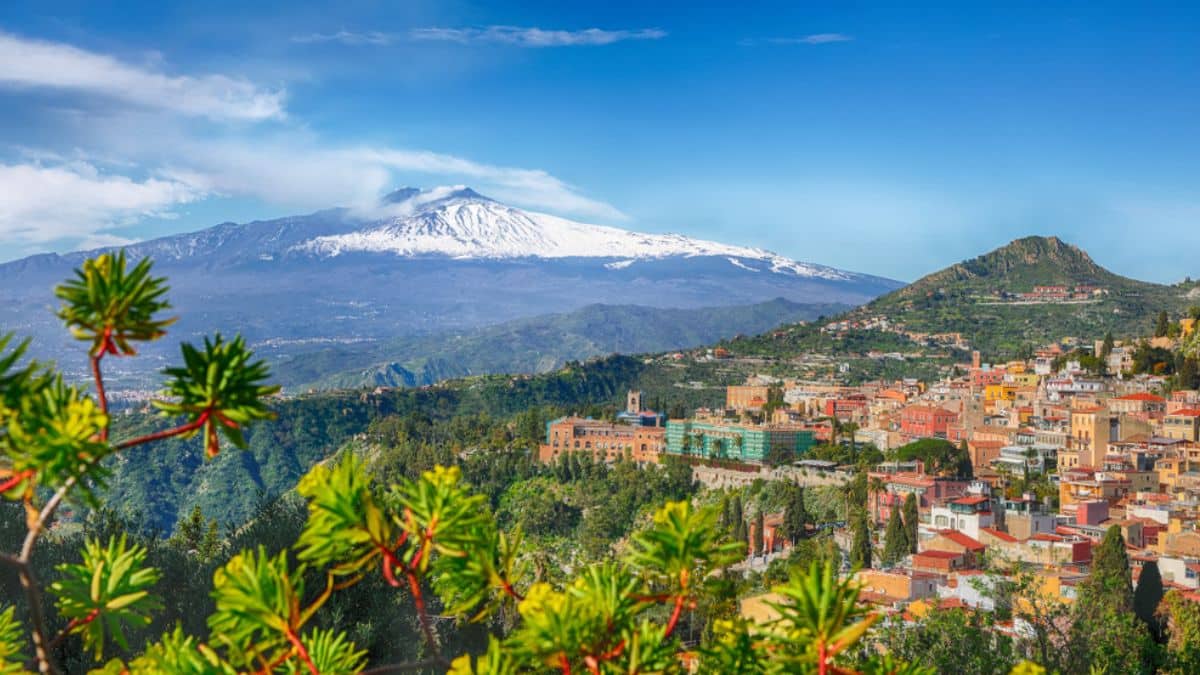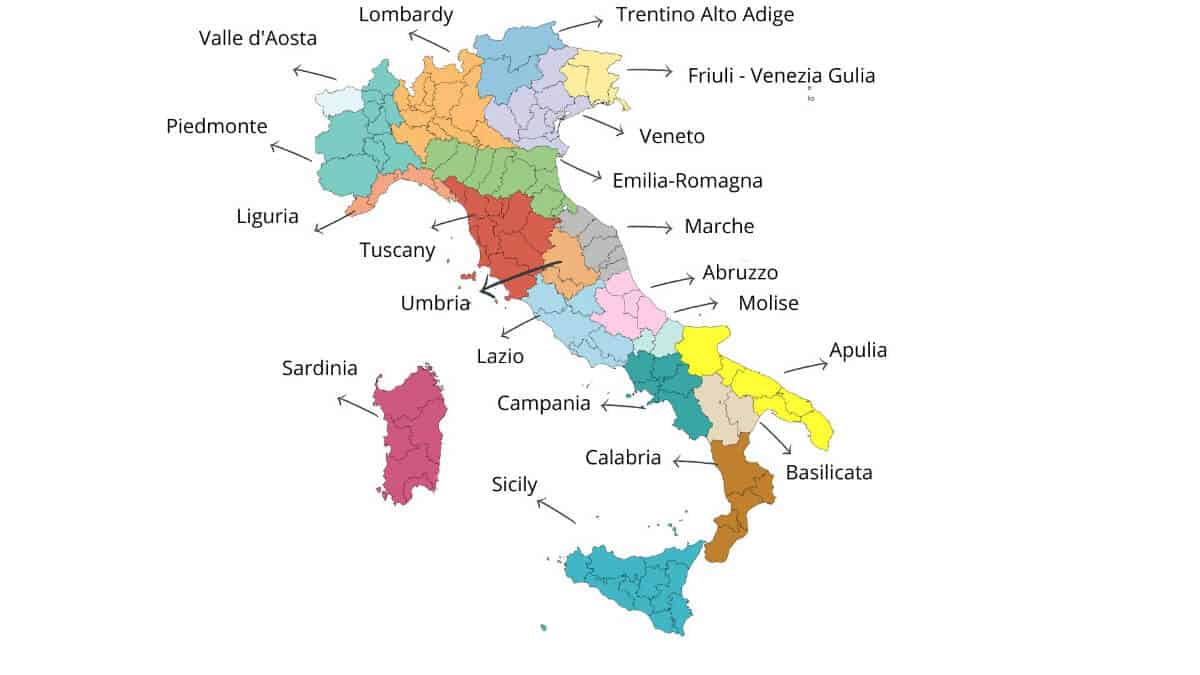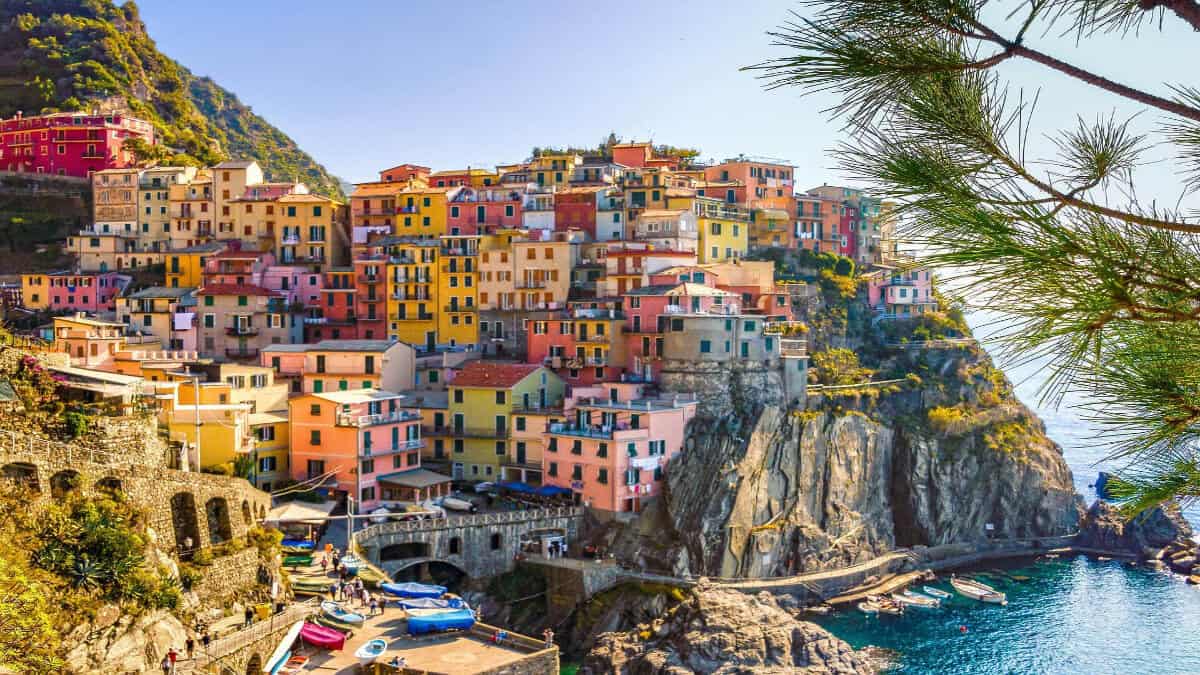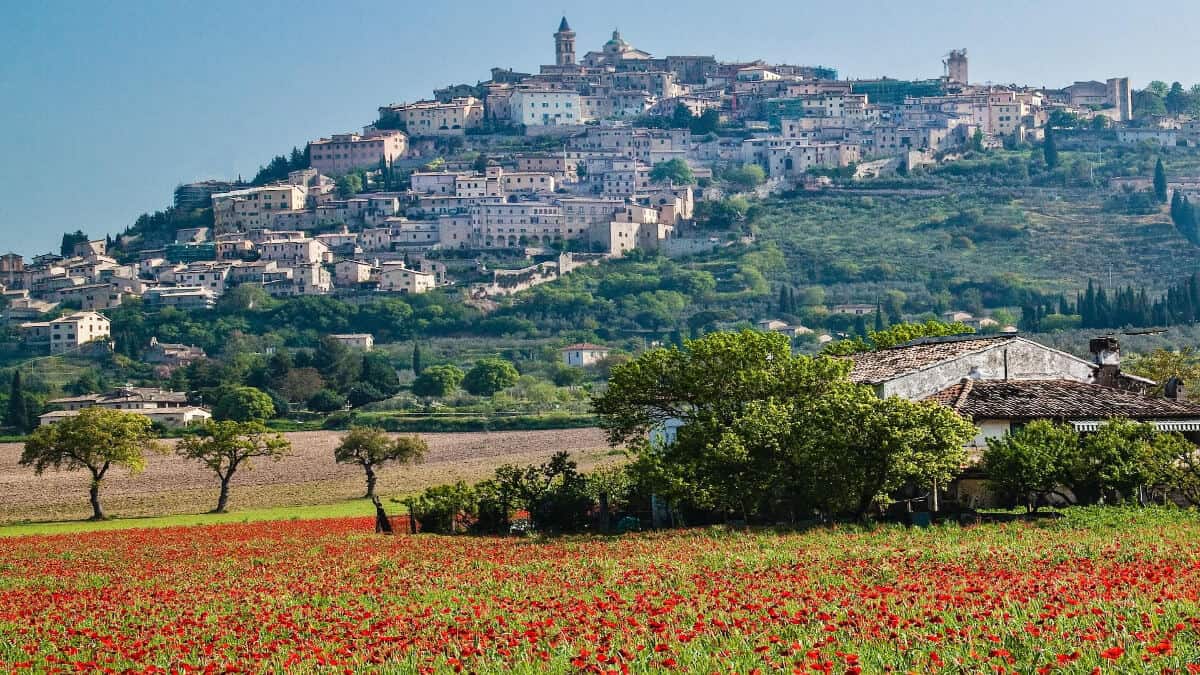There are many different regions of Italy to explore, each with its unique charm and character, whether it’s the water canals of Venice, the rolling hills of Tuscany, or the breathtakingly beautiful Amalfi Coast.
When I think of Italy, I picture iconic narrow streets, blue waters, delicious Italian pizza, or the Eat Pray Love movie scene of Julia Roberts eating ice cream in the cobblestone streets of Rome.
This great country on the Italian peninsula is full of history, culture, romantic coastlines, and natural beauty. So it’s no surprise that it is one of Europe’s most desirable tourist destinations.
But with so many popular tourist attractions and sights, you might wonder where to start your exploration.
Italy was my first travel destination, and it was love at first sight. Or, as Italians would say: ‘amore a prima vista.’
In this blog post, I’ll break down all 20 regions of Italy and the highlights of each one of them, plus my favorite things to do in Italy.
Basic Info About Regions of Italy

The Italian republic is organized into 20 administrative divisions, including five autonomous regions – Venezia, Sardinia, Sicily, Trentino-Alto Adige / SüdTirol and Val d’Aosta.
These regions belong to Italy; however, they became autonomous to protect cultural differences and linguistic minorities.
Autonomy grants them some legislative, administrative and financial power to a varying degree. For example, the autonomous regions can keep more provincial taxes compared to the other regions of Italy.
Besides that, Vatican city is considered an independent city-state, making it the smallest country in the world.
The Vatican is the home of the Pope and a spiritual hub for Catholics.
Each Italian region has the main city, also known as the ‘capoluogo di region.’
Italy’s capital is Rome which is the largest city.
Other main metropolitan cities are Milan, Naples, Turin, Palermo, Bari, Catania, Bologna, Florence, Venice, Genoa, Messina, Reggio Calabria, and Cagliari.
According to the latest statistics (2022), the population of Italy is around 60 million.
Fun Facts About Italy

The Italian peninsula is known for its food, romantic coastline, and boot-like shape. But here are a few more things that perhaps you haven’t heard yet:
- All three of Europe’s active volcanoes are in Italy.
- Pizza was first made in Naples.
- Italy has a free wine fountain in Caldari di Ortona in the Abruzzo region.
- Italy has the highest number of UNESCO sights in the world.
- There are more than 1500 lakes in Italy; some of the most famous Italian lakes are Lake Como, Lake Maggiore, and Lake Garda.
- Italy is the world’s largest wine producer.
- Italy has the oldest population in Europe.
- Tourists throw over 3000 euros into Fontana di Trevi in Rome daily.
- Italy has over 2000 types of cheese.
The Best Time to Visit Italy

For beach holidays in Italy, the best time to visit is between May and October.
If you want to enjoy all Italy offers without the large crowds, I recommend avoiding summer (July-August) altogether.
Not only is it incredibly hot during this time of year, but many Italians take their summer holidays in August during the so-called ‘Ferragosto,’ so many businesses are closed.
You might also find cheaper flights outside the main summer season.
If you love hiking, the best time to come is spring (March-May) or autumn (September-November).
During these months, the temperatures are still pleasant, and there are fewer tourists.
Winters in Italy (December-February) can be cold, but if you don’t mind bundling up, it can be a great time to visit.
Many popular tourist attractions are less crowded during winter, and you might experience the festive atmosphere of Christmas markets in Italy plus world-class ski resorts in the Italian Alps.
Map of Italy Regions

Italy’s Regions and Places to Go From North to South
| Regions of Italy | Main City | Main Tourist Attractions |
| Aosta Valley / Valle d’Aosta | Aosta | Mt Blanc, Matterhorn, Gran Paradiso National Park |
| Piedmont / Piemonte | Turin (Torino) | Turin, Lake Maggiore, Orta Lake, Val Grande National Park, Sacra di San Michele |
| Lombardy / Lombardia | Milan (Milano) | Milan, Lake Como, Lake Garda |
| Veneto | Venice (Venezia) | Venice, Verona |
| Trentino Alto Adige | Trento | Dolomites |
| Friuli Venezia Giulia | Trieste | Trieste, Udine |
| Emilia Romagna | Bologna | Bologna, Parma, Ravenna |
| Liguria | Genoa (Genova) | Cinque Terre, Portofino, Genoa |
| Tuscany / Toscana | Florence | Florence, Siena, Pisa, San Gimignano, Monte Pulciano, Pienza |
| Marche | Ancona | Umbrino, Conero, Loreto, Corinaldo |
| Abruzzo | L’Aquila | Gran Sasso National Park, Scanno, Majella National Park |
| Umbria | Perugia | Perugia, Assisi, Spello, Rasiglia |
| Lazio | Rome | Rome, Vatican |
| Campania | Naples | Amalfi Coast, Sorrento, Capri, Pompeii, Mount Vesuvius |
| Molise | Campobasso | Termoli |
| Apulia / Puglia | Bari | Bari, Trulli houses |
| Basilicata | Potenza | Matera, Maratea |
| Calabria | Reggio Calabria | Tropea, Capo Vaticano, Pizzo Calabro |
| Sicily / Sicilia | Palermo | Palermo, Taormina, Siracusa, Valley of the Temples, Noto Valley, Mt Etna |
| Sardinia / Sardegna | Cagliari | Costa Smeralda, Alghero, Stintino, Piaggia Rossa |
Aosta Vally / Valle d’Aosta

Aosta Valley / Valle d’Aosta is the smallest region of Italy. It’s located in the northwest corner of the country and is bordered by France and Switzerland.
The main city here is Aosta, a great base for exploring the nearby mountains and national parks.
Some of the most popular attractions in Aosta valley are Mt Blanc, Matterhorn, and Gran Paradiso National Park.
If you love the outdoors, this is definitely the place to go! There are plenty of hiking and skiing opportunities in Valle d’Aosta.
In winter, you can even go dog sledding or ice climbing.
Fun Fact: The most well-known cheese from Aosta Valley is Fontina.
Piedmont / Piemonte

Piedmont is another region located northwest of Italy next to the French and Swiss border. The main city here is Turin.
Some popular places to visit in Piedmont are Lake Maggiore, Orta Lake, Val Grande National Park, and the Sacra di San Michele.
If you’re into history and art, you can also explore the Royal Palace of Venaria Reale or the Egyptian Museum in Turin.
Piemonte is the land of truffles and hard-hitting savory wines such as Barolo and Barbaresco.
For wine tasting or a scenic ride on an Italian Vespa, you can head to Alba.
Fun Fact: Italian cars Fiat are originally manufactured in Turin.
Lombardy / Lombardia

Lombardy is one of the most affluent and economically developed regions of Italy. It’s in the country’s north, and its main city is Milan.
Milan is a fashion and business hub in Italy.
If you love shopping, then Milan is the place to be. In Galleria Vittorio Emanuele, you can find many luxurious fashion brands such as Prada, Gucci, and Versace.
Milan also has plenty of museums and art galleries to explore. For example, Pinacoteca di Brera contains one of Milan’s largest and most stunning collections of Italian paintings.
You will not want to miss out on seeing Leonardo da Vinci’s masterpiece – The Last Supper. It’s painted on the wall of Santa Maria Delle Grazie in Milan.
But Lombardy is much more than just Milan and the Duomo cathedral.
Some of the other popular tourist destinations are Bergamo, Brescia, and Pavia.
Just a short drive from Milan is Lake Como and Lake Garda.
Lake Garda is the largest Italian lake. You’ll be amazed by the breathtaking scenery and many charming small towns and villages dotted around the lake, such as Bardolino, Gardone Riviera, Malcesine, and Sirmione.
Fun fact: George Clooney owns a home on Lake Como.
Veneto

Veneto is in the northeast of Italy. Its main city is Venice.
Venice is one of those unique iconic places in Italy and the entire world. Nothing is quite like the Venetian water canals, gondolas, and Gothic palaces.
Other must-see places in Veneto are Verona, home of Shakespeare’s Romeo and Juliet, and Padua, where you can see the incredible art paintings inside Scrovegni Chapel.
Riviera del Brenta links Venice and Padua with many Venetian villas along the way, making it a perfect route for a cycling trip or a short drive.
Many outdoor concerts take place at the Roman Arena in Verona. Thanks to the colosseum-like shape of the arena, the sound quality is top-notch.
Fun Fact: The Juliet Wall with messages of love depicted in the movie Letters to Juliet truly exists. The exact address is 23 Via Capello. So perhaps, you might come and write your own love letter to Juliet.
Trentino Alto Adige

Trentino Alto Adige is located in the northeast corner of Italy and is one of the most mountainous regions in the country.
The main city is Trento.
In this area of Italy, you can go exploring the nearby Dolomites.
Some other popular places to visit in Trentino Alto Adige are Lake Idro and Val di Sole, with prime views of the Alps.
If you love skiing or snowboarding, this is definitely the place for you! There are plenty of world-class ski resorts in Trentino Alto Adige, such as Madonna di Campiglio and Ortisei.
Fun Fact: Trentino Alto Adige used to be part of Austria, and to this day South Tyrolean German language is widely spoken in this region.
Friuli Venezia Giulia

Friuli Venezia Giulia is a region located in the northeast of Italy. Its main city is Trieste.
There are 13 nature reserves in this Italian region which speaks for itself.
The main attractions in Friuli Venezia Giulia are Castello di Miramareare, hiking trails and Friuli wineries.
For the adrenaline rush, you can try the Treviso alpine bob coaster, paragliding in Gemona, or bike the Alpe Adria, rated one of the best cycling routes in Europe.
Fun Fact: The world’s largest sailing regatta (Barcolana) takes place in Trieste on the second Sunday of October.
Abruzzo

The Abruzzo region is in central Italy, and its main city is L’Aquila.
Abruzzo has some of the most natural beauty in the country.
You will be spoiled for choice in Abruzzo if you love hiking or mountains.
There are many stunning national parks, including the National Park of Abruzzo, Majella National Park, and Gran Sasso e Monti della Laga National Park.
Fun Fact: There is a free wine fountain in Caldari di Ortona.
Emilia Romagna

Emilia Romagna is part of northern Italy. Its main city is Bologna.
The major tourist spots in Emilia Romagna are Parma, Ravenna, Rimini.
The popular Italian delicacy spaghetti Bolognese comes from this region.
For an off-the-beaten-path experience, you can explore Cesenatico, an old fishing village at the seaside. There is also an annual fishing festival Pesce Fa Festa towards the end of October / beginning of November.
Emilia Romagna is known for its medieval architecture. If that interests you, you’ll want to check out the local churches and castles.
Some of the most famous places are the Sanctuary of di Madonna San Luca and Castello di Dozza, a beautifully preserved castle that dates back to the 13th century.
Fun Fact: Emilia Romagna is the birthplace of Lamborghini, Ferrari, and Maserati.
Fun Fact 2: ‘The king of cheese’ Parmesan / Parmigiano Reggiano comes from this region. The original parmesan can only be produced in Emilia Romagna due to the region’s climate and unique fauna to protect the cheese quality and flavor.
Liguria

Liguria is in northwest Italy. Its main city is Genoa.
One of the absolute must see places in Liguria is Cinque Terre, which means ‘five lands‘ as it consists of five villages: Monterosso al Mare, Vernazza, Corniglia, Manarola and Riomaggiore.
You can get around Cinque Terre by train or boat.
There are also hiking trails that connect all five villages with stunning coastal views. The most popular trail is called Via dell’Amore or ‘the path of love.’
Another gorgeous spot in Liguria is Portofino, a small village with a picturesque harbor and luxury hotels.
Portofino is a perfect spot to enjoy coastline views while sipping a glass of wine and watching the sunset from one of the many cafes or restaurants around the harbor.
Fun Fact: Cinque Terre is a UNESCO World Heritage Site.
Fun Fact 2: Genoa is home to Italy’s first lighthouse (Lanterna), built in 1326.
Tuscany / Toscana

Tuscany is located in central Italy, and its main city is Florence.
Some of Tuscany’s most popular tourist attractions are the leaning tower of Pisa, Siena Cathedral in Florence, and Pienza.
Tuscany is famous for its Winelands, but you probably haven’t heard about the lesser-known natural hot springs Bagni di Petrioli. It’s a fun place to stop by for a relaxing day after drinking wine and sightseeing.
Another worthwhile visit is San Gimignano, a small town with medieval architecture.
Fun Fact: Chianti and Montepulciano wine come from the Tuscany region.
Fun Fact 2: Gladiator movie, specifically the scene of Russel Crowe walking back home through a panoramic field surrounded by Cypress trees, was filmed in Pienza, Val d’Orcia.
You might also like:
Marche

The Marche region is part of central Italy, and its main city is Ancona.
Popular tourist attractions in the Marche region are Conero, Numana, Recanati, Loreto, and Urbino.
If you’re looking for a unique experience, you can go hiking in the Monti Sibillini National Park and admire blooming poppies. Red poppies bloom in the second half of May and the first week of June.
Fun Fact: The Marche region is home to some of the best white wines in Italy including Verdicchio dei Castelli di Jesi and Bianchello del Metauro.
Fun Fact 2: The town of Urbino was the birthplace of the famous painter Raphael.
Umbria

Umbria is a region in central Italy. Its main city is Perugia.
Perugia, Assisi, Spello, Rasiglia, Orvieto and Spoleto are some of the most popular tourist destinations in Umbria.
If you love the outdoors, you can check Marmore waterfalls or go rafting on the Nera river.
Fun Fact: The town of Perugia is home to the chocolate festival ‘Eurochocolate,’ which takes place every October.
Lazio

Lazio is another central Italian region. Its main city is Rome.
With 3000 years of history, there are more than enough things to do, see and taste in Rome. But one of the top tourist stops is the Colosseum, Peter’s Square, Fontana di Trevi, Spanish steps, and Vatican City.
For an off-the-beaten-path experience, you can visit Hadrian’s Villa or Lake Bolsena.
Fun Fact: Rome is home to over 900 churches.
Campania

Campania region forms part of southern Italy. Its main city is Naples.
Campania is known for the Amalfi Coast, Capri island, Mount Vesuvius, and Pompeii.
For a unique experience, you can take a cooking class in beautiful Sorrento or explore the lost city of Pompeii.
Pompeii was destroyed by the volcano eruption of Mount Vesuvius, which is still considered an active volcano to this day.
Positano on the Amalfi Coast is hard to beat for a romantic getaway. There are many cute little restaurants and cafes to enjoy the breathtaking views of the Mediterranean sea.
You can go for a swim in the crystal-clear waters or take a boat trip to explore the coast.
Fun Fact: The pizza Margherita was invented in Naples in 1899.
Molise

Molise is a region located in southern Italy. Its main city is Campobasso.
Popular tourist attractions in Molise are the medieval castles of Termoli and Larino, the monastery of San Vincenzo al Volturno.
Fun Fact: Molise is full of ghost towns / abandoned villages such as Rocchetta Volturno.
Apulia / Puglia

The Puglia region is located in southern Italy. Its main city is Bari.
The main attractions in Puglia are its beaches and Trulli houses.
The most spectacular beaches of Apulia can be found on the Ionian coast, such as Punta Prosciutto and Maladive de Salento. Stop at Grotta della Poesia, a natural swimming pool with crystal clear water perfect for swimming.
Puglia’s most interesting tourist attractions are the Trulli houses in Alberobello and Castel del Monte.
The Trulli houses are traditional conical-roofed houses made of stone. They are unique to this region and unlike anything you’ve seen before.
Fun Fact: Puglia is the largest producer of olive oil in Italy.
Basilicata

Basilicata is a region located in southern Italy. Its main city is Potenza.
Some of the most popular tourist attractions in Basilicata are the towns of Matera and Maratea.
Matera is famous for its cave dwellings known as ‘sassi.’ These houses were carved from the rock and are a UNESCO World Heritage Site.
Maratea is a beautiful town with over 30 churches and 14 beaches. It is often referred to as the ‘Pearl of the Tyrrhenian Sea.’
Fun Fact: There is an oil field in Val d’Agri in Basilicata.
Calabria

Calabria is a region located in the south of Italy, right at the toe of the Italian boot-shaped peninsula. Its main city is Reggio Calabria.
Calabria has over 500 miles of coastline.
Some of the best beaches are Tropea and Capo Vaticano.
For a romantic getaway, check out Pizzo Calabro on the Tyrrhenian coast. You can enjoy delicious Calabrian cuisine and breathtaking sea views from one of the many cafes and restaurants.
Fun Fact: Calabria is known as the land of Bergamot.
Fun Fact 2: Gianni Versace was born and raised in Reggio Calabria.
Sicily

Sicily is an island region located in the very south of Italy. Its main city is Palermo.
Sicily is popular for its beaches, delicious Sicilian cuisine, ancient ruins, and mountain villages.
The best beaches, such as Mondello and Isola Bella, are on the east coast.
Some of Sicily’s most interesting tourist attractions are the ruins at Agrigento and Selinunte and the Norman cathedral in Palermo.
For a unique experience, you can take a cable car up to the top of the active Mount Etna volcano.
The food in Sicily is amazing! You can eat everything from fresh seafood to traditional Sicilian dishes.
You’ll definitely want to try some of the local specialties like arancini (fried rice balls), caponata (eggplant dish), and cannoli (ricotta sweet pastry).
Fun Fact: Mount Etna is Europe’s tallest volcano.
Sardinia / Sardegna

Sardinia is an Italian island. Its main city is Cagliari.
With more than 200 beaches on the island, it’s hard to choose where to take a dip and sunbathe first.
Sardinia even has a pink beach (Spiaggia Rossa).
My personal favorite is Stintino. Some other popular beaches are on the east coast, such as Costa Rei and Cala Goloritze.
Many celebrities have their houses and yachts in Costa Smeralda.
For an unusual experience, you can find wild pink flamingos in Molentargius park.
Fun Fact: Sardinia has an island full of white albino donkeys called Asinara.
Fun Fact 2: A local Sardinian dish is rotten cheese ‘Casu Marzu’ with live maggots.
Top Things to Do in Italy

There are so many amazing places to see in Italy that it would be impossible to cover them all in this post, but here are my personal favorite things to do:
- Explore the Colosseum in Rome
- Throw a coin in Fontana di Trevi
- Spend the day at the Uffizi Gallery
- Admire Michelangelo’s paintings at the Sistine Chapel
- Get a bird’s eye view of Florence from Piazzale Michelangelo
- Ride a gondola through the canals of Venice
- See the Leaning Tower of Pisa
- Visit Pompeii and Herculaneum
- Eat pizza in Naples
- Take a scenic Vespa ride along the Amalfi Coast
- Go wine tasting in Tuscany
- Spoil your taste buds in Sicily
- Go skiing in the Italian Dolomites
- Take a dip in the blue waters of Stintino in Sardinia
- Stroll through the romantic, picturesque villages of Cinque Terre
- Take a ride with the Treviso Alpine bob coaster
- Cycle in the Italian Riviera
- Walk through crop fields of Val d’Orcia in Tuscany
- Visit the iconic Romeo and Juliet balcony in Verona
- Explore Trulli houses in Alberobello
- Eat lots of gelato in any region of Italy
How to Get Around Regions of Italy

There are a few different options for getting around the regions of Italy.
Flying
The first and the most convenient option is to fly to one of the 77 Italian airports and rent a car.
For budget-friendly flight tickets, I recommend Ryanair.
Car Rentals
Renting a car is a great option, especially if you plan to visit multiple regions. Car rentals are generally quite affordable in Italy. At DiscoverAuto, you can find some good deals around 25-35 EUR per day for a multi-day rental. Make sure you get an International Driving Permit (IDP) before leaving your home country.
Train
Another option is to take the train. Italy’s extensive rail network can get you to most places across Italy’s regions. On the ItaliaRail website, you can book tickets, check prices, and select different train routes.
A high-speed train from Rome to Milan costs on average 100 euros.
If you have a low budget, you can opt for slower Regionale trains at a much lower rate.
Public Transportation
If you’re planning on staying in one region, then the best option is to use public transportation. Most regions have local city buses or trams that can take you where you need to go for reasonable prices.
Some larger cities such as Rome, Milan, Turin, Naples, and Genoa also have an extensive metro network.
Buses
If you want to move between different regions of Italy, you can also consider long-distance bus companies such as Flixbus or Megabus. Traveling by bus will be much cheaper than a train. The only downside is that it’s slower. Most buses even have wifi.
Ferry
Another option, especially if you’re planning to visit the islands or coastal regions of Italy, is to take a ferry. There are many different ferry companies in Italy with routes all around the country. For more info, check Ferryhopper.
So there you have it – a quick travel guide to enchanting regions of Italy.
Italy is a country that has something for everyone, whether you’re a foodie, beach lover, or history enthusiast.
I hope this article has inspired you to experience Italian dolce vita (sweet life) for yourself.
Which regions of Italy are you most interested in visiting, or have you visited?
Ciao for now!
Kamila is a freelance writer for hire and a blogger. On her blog, Expat in Canada, she and her partner provide useful information about life in Canada. When she’s not writing, you can find her on a yoga mat, coaching, or drinking a cup of tea.

